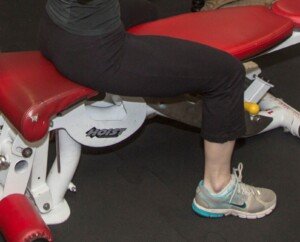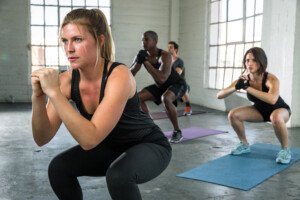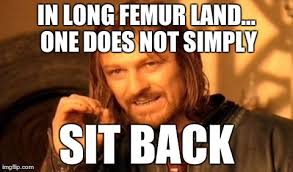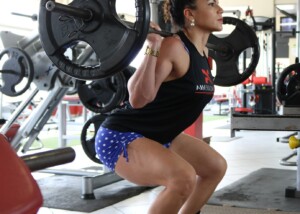If you can’t get parallel with squats and fall backwards instead or must hold something in front of you, you won’t like the reason.
Many things have been blamed for not being able to go parallel with squats (free barbell or bodyweight), and often, the most likely culprit gets overlooked.
If you struggle to reach parallel with free barbell or bodyweight squats, you may want to take a look at the length of your thigh relative to your shin. Are you “long thighed” or “short thighed”?
This relativity factor is NOT related to overall body height.
If when you wear shorts, you’re “all thighs,” chances are you have the so-called long femur.
A femur that seems too long for the shin is very likely longer than your torso, and therein lies the problem.

Long femur, short shin
When it comes to barbell or bodyweight squats, a long femur (thigh bone) is a biomechanical disadvantage, especially when paired with a short torso.
In fact, regardless of a person’s height or relative shin length, if their femurs are longer than their torso, this puts them at a disadvantage in the squat.
Many other variables have been blamed on being unable to go parallel with the squat:
Lack of flexibility in the ankles and hips
Weak anterior tibialis muscle (muscle in front of calve)
Stiff lower back; tight calves and poor form.
General weakness. An out-of-shape person, even with femur length shorter than torso length, will likely struggle and end up with bad form (rounded back, hunched shoulders, arms needing to be extending out front to prevent toppling backwards).
Though these are all legitimate reasons for difficulty in parallel squatting, they can also be corrected.
If your femurs are relatively long compared to your shins, coupled with a torso shorter than the femurs, you’re in big trouble.
To counteract the anatomical problem, what must you do?
Someone with poor anthropometrics for the squat must lean their torso very far forward — so far forward that they can lose the arch in their lower back that they’re supposed to have when doing the squat.
In these cases, the back is rounded, chest down. They aren’t in a squat; they are in a crouch.
But even if the back remains straight, it’s still leaned WAY too far forward.
To keep from falling backwards in the barbell squat when parallel, you must have the barbell positioned right over your ankles/midfoot.
To achieve this, the long-femur man or woman (especially with short shins) must really pitch forward to get that barbell over the ankle.
This forces the lower back muscles to absorb considerable tension, increasing injury risk to the lower back and subtracting workload from the quadriceps and glutes.
If a person has great flexibility at the junction of the shin and foot, as well as Achilles tendon flexibility, they could move their knees far ahead of their feet (increase bend in foot/shin junction), which would bring their hips (center of gravity) forward, to get the barbell over the ankles/midfoot.
This would enable him or her to keep balance without leaning their torso over so much.
However, there are several problems here.
1) The shin/foot/Achilles flexibility needs to be developed and may never be enough
2) The knees being so far ahead of the feet puts one in an inefficient position to handle heavy weight, since workload is shifted away from the butt and hamstrings and concentrated too much on the quadriceps, and
3) This positioning puts undue stress on the knees.
The inability to get the feet flat on the floor while in a parallel squat is typically blamed on “poor ankle flexibility.”
Check your femur-to-shin or femur-to-torso proportion; chances are extremely high that this is the problem with parallel squat difficulty.
Now, imagine someone, let’s call him Henry, with very short femurs and crazy long shins; exaggerate these features in your mind as you mentally illustrate the profile.
Henry lowers into a squat. Note how close his hips are to his knees while his thighs are parallel.
With his very long torso, note that Henry hardly has to lean forward to get the barbell over the midpoint of his feet.
The angle that’s created by Henry’s torso with his thighs is significantly bigger than the angle created by the long-femur, short-torso counterpart.
If Henry’s spine is long enough and femurs short enough, his back will be practically upright while he’s parallel in the squat.
Lorra Garrick is a former personal trainer certified through the American Council on Exercise. At Bally Total Fitness she trained women and men of all ages for fat loss, muscle building, fitness and improved health.
.










































